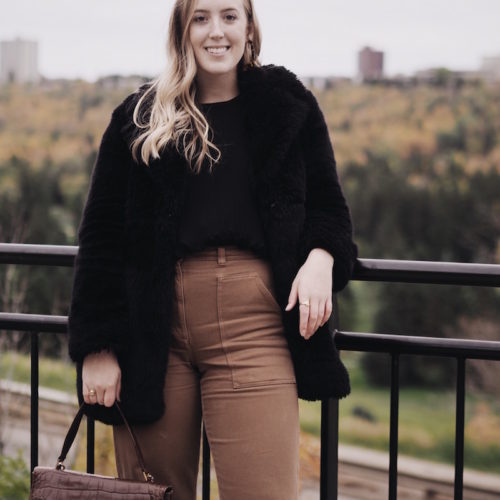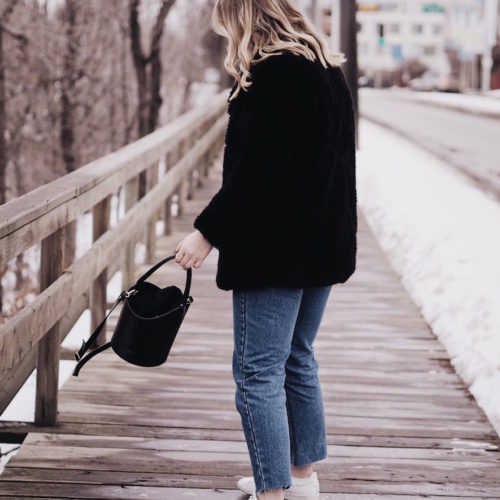Thrift shopping has become one of my favourite past times this past year. The thrill of finding pieces super cheap, really unique AND better for the environment, now that’s the trifecta! Keep reading for my tips on everything I do when I go to the thrift store to help you find those killer pieces!

I had always loved to go thrift shopping, but it was this past year that I really perfected the craft. It’s hard work, especially with so many options for so cheap; you have to know what you want!
I can honestly say that thrifting is all about practice and patience. It sounds cliché, but you have to be prepared for the idea that you might not find anything good, and then do it all over again hoping that that time you will! It’s a mind game if I’m being honest ha!
9 Top Tips for Becoming a Pro Thrift Shopper
1. Give yourself TIME
These thrift stores are huge. You need to have enough time to go through all the things you want to search for (see step 2). If you think you’re bad at thrift shopping, honestly, you’re probably just not giving yourself enough time to find anything. It can take FOREVER to find pieces that have potential in racks and racks of crap.
2. Know what you’re looking for
There’s nothing that ruins a good thrift shopping run than going without a plan. Thrift stores are HUGE, so you have to at least have some idea what you’re looking for. I find there are things that I usually look for because those are the pieces I love finding secondhand. My plan is always the same, when I have more time or I’m really in the thrift shopping mood, I’ll add in extras.
a) Bags
The amount of real leather vintage bags is crazy when you take the time to look. Usually the bag section only takes a small scan to see if there’s anything worth it, since it’s usually smaller than the clothing sections. It’s pretty easy to tell which ones are nice and which can be left behind. I wrote a post all about what I look for when I thrift for bags which you can take a peak at here.
b) Denim/Pants
This is also a relatively easy section to search in since you’re really limited to looking at size sections of the racks that actually fit your body. Plus, the good quality jeans usually stand out in the sea of Walmart jeggings.
c) Coats/Jackets/Blazers
I love this section because people always donate the coolest outerwear and you don’t have to stick to particular sizes. I usually look for patterns or fabrics that I love to wear; that means the pieces I usually pull are leather, pretty plaids, soft furs, etc.
The crappy thing about this section is the vast majority are going to be too big on you. That’s what I’ve found in my thrifting experience anyways.
d) Dresses
I seem to have good luck with dresses so now I make it a priority to take a peak. There’s lots of fabric on a dress and that lets me usually see if it’s worth spending more time looking at once I’ve done my initial scan.
e) Homeware
I love looking for homeware because it’s normally a quick scan of the shelves to see if there’s anything good. I always look for brass items because I love the look of vintage brass, Tuperware containers in perfect condition, and any other cool looking things I think I’d actually use or display in my home.
If I have more time, I’ll look at sweaters and if I’m feeling crazy, tops. They are usually the largest sections filled with a lot of crappy pieces. You can get lucky for sure, but for me, it’s often not worth it. I have found some awesome pieces like this brand new top, but those are few and far between.

3. Look at the tags first
The tags give you almost everything you need to know about a piece. Vintage looking tags are always a win because they usually do suggest a vintage piece. I always look to the tag to tell me where it was made and what it’s made out of. Vintage items are usually made in Canada, US or European countries and I’ve found to have better longevity.
That’s definitely not to say that I haven’t bought anything secondhand from a fast fashion retailer. When that’s the case, you really have to make sure you look at what shape the piece is in. If it looks a little worn, leave it because it’s likely to show wear faster.
4. Notice the fabrics
Fabrics are obviously a big part of how good a piece is. It’ll tell you how well the item was made, how well it’s going to hold up and more than that, it gives you a glimpse of ways you could style it.
When I look at the fabrics, the first thing I notice is obviously the pattern. If I don’t like the pattern, it’s an obvious and quick no from me. I make sure to note how easily it wrinkles, if it’s super staticky and if there are any imperfections. These are all surefire ways to easily decide that a piece isn’t for you, and avoid pieces that you’ll never wear.
5. Location MATTERS
More affluent areas tend to have better pieces at the thrift store because they give away better things or things without as much wear. Not saying you can’t find some great pieces anywhere you go, but to give yourself the best chance, hit up those boujee places in your city.
If you’re in Edmonton, I usually find my best pieces at the Calgary Trail Goodwill or the Goodwill on the West end by the Henday. The next locations I’m excited to hit up are St. Albert and Stony Plain for their goodies!

6. Look at the price
If you’re going thrifting for the purpose of reselling later, you really have to keep your eye out on the tags. Even if you find a killer piece, if it’s overpriced, you won’t be able to make any money on it. Obviously this is less important if you’re shopping for yourself, but you also have to weigh how much you’ll wear it versus the price.
7. Don’t buy if you won’t wear it
I learned this the hard way when I used to thrift. If I found something cool I would buy it regardless if I actually thought I would wear it or not. It was slightly a slap in the face when I would walk into my closet and see pieces in there from the thrift store that I spent money on but never actually wore. In reality, that’s just a huge waste of my time, space and money.
When you’re shopping, actually think about if you’d wear it in your everyday life. A basic sweater or denim jacket can be worn over and over again, but if you’re buying things even if they only kind of fit, try your best to leave them behind. You can always find something else!
8. Try on EVERYTHING with potential
You won’t know it until you try it on. Literally. There have been a more times than not that I walk out of the store with a piece I was hesitant about before I went to the fitting room. Even vice versa, there were times that I thought I found an absolute gem in the rough, but when I went to the fitting room… I had no idea what was happening with what I had just tried on.
If you find a piece that you just KNOW has potential but still doesn’t fit you, consider gifting it to someone with a body that would better fit it or sell it online. I’ve found success in both! If there’s something there that I can’t part with but it’s no bueno for me, I usually throw it up on my Poshmark because someone needs to be wearing it!

9. A lot of pieces can be reworked
If you like a piece but you’re not sold that you would wear it, consider reworking it! I’ve done a few DIYs with my thrifting finds over the past year and I loved the pieces SO much more once I changed them up.
One of my go-tos is distressing denim from the thrift store. I made a whole post about it here where I teach you exactly how I distress my denim and how you can too! Another easy fix, is change out the buttons. I changed one button on the pants in this post that I found at Goodwill, and I swear to you, they were like a whole new pair of pants.
I honestly can’t get ENOUGH of thrift shopping. It feels like I’m addicted to the thrill of finding beautiful things for pennies, and it’s not something I’ll be stopping any tome soon!
You can follow me on Instagram where I document all my thrifting finds on my stories, or pop a question down below if you’re curious about something!
xx Victoria




Leave a Reply